#The French film banned in France !
Explore tagged Tumblr posts
Text
The Women of the French Revolution (and even the Napoleonic Era) and Their Absence of Activism or Involvement in Films
Warning: I am currently dealing with a significant personal issue that I’ve already discussed in this post: https://www.tumblr.com/nesiacha/765252498913165313/the-scars-of-a-toxic-past-are-starting-to-surface?source=share. I need to refocus on myself, get some rest, and think about what I need to do. I won’t be around on Tumblr or social media for a few days (at most, it could last a week or two, though I don’t really think it will).
But don’t worry about me—I’m not leaving Tumblr anytime soon. I just wanted to let you know so you don’t worry if you don’t see me and have seen this post.
I just wanted to finish this post, which I’d already started three-quarters of the way through.
One aspect that frustrates me in film portrayals (a significant majority, around 95%) is the way women of the Revolution or even the Napoleonic era are depicted. Generally, they are shown as either "too gentle" (if you know what I mean), merely supporting their husbands or partners in a purely romantic way. Just look at Lucile Desmoulins—she is depicted as a devoted lover in most films but passive and with little to say about politics.
Yet there’s so much to discuss regarding women during this revolutionary period. Why don’t we see mention of women's clubs in films? There were over 50 in France between 1789 and 1793. Why not mention Etta Palm d’Alders, one of the founders of the Société Patriotique et de Bienfaisance des Amies de la Vérité, who fought for the right to divorce and for girls' education? Or the cahier from the women of Les Halles, requesting that wine not be taxed in Paris?
Only once have I seen Louise Reine Audu mentioned in a film (the excellent Un peuple et son Roi), a Parisian market woman who played a leading role in the Revolution. She led the "dames des halles" and on October 5, 1789, led a procession from Paris to Versailles in this famous historical event. She was imprisoned in September 1790, amnestied a year later through the intervention of Paris mayor Pétion, and later participated in the storming of the Tuileries on August 10, 1792. Théroigne de Méricourt appears occasionally as a feminist, but her mission is often distorted. She was not a Girondin, as some claim, but a proponent of reconciliation between the Montagnards and the Girondins, believing women had a key role in this process (though she did align with Brissot on the war question). She was a hands-on revolutionary, supporting the founding of societies with Charles Gilbert-Romme and demanding the right to bear arms in her Amazon attire.
Why is there no mention in films of Pauline Léon and Claire Lacombe, two well-known women of the era? Pauline Léon was more than just a fervent supporter of Théophile Leclerc, a prominent ultra-revolutionary of the "Enragés." She was the eldest daughter of chocolatier parents, her father a philosopher whom she described as very brilliant. She was highly active in popular societies. Her mother and a neighbor joined her in protesting the king’s flight and at the Champ-de-Mars protest in July 1791, where she reportedly defended a friend against a National Guard soldier. Along with other women (and 300 signatures, including her mother’s), she petitioned for women’s rights. She participated in the August 10 uprising, attacked Dumouriez in a session of the Société fraternelle des patriotes des deux sexes, demanded the King’s execution, and called for nobles to be banned from the army at the Jacobin Club, in the name of revolutionary women. She joined her husband Leclerc in Aisne where he was stationed (see @anotherhumaninthisworld’s excellent post on Pauline Léon). Claire Lacombe was just as prominent at the time and shared her political views. She was one of those women, like Théroigne de Méricourt, who advocated taking up arms to fight the tyrant. She participated in the storming of the Tuileries in 1792 and received a civic crown, like Louise Reine Audu and Théroigne de Méricourt. She was active at the Jacobin Club before becoming secretary, then president of the Société des Citoyennes Républicaines Révolutionnaires (Society of Revolutionary Republican Women). Contrary to popular belief, there’s no evidence she co-founded this society (confirmed by historian Godineau). Lacombe demanded the trial of Marie Antoinette, stricter measures against suspects, prosecution of Girondins by the Revolutionary Tribunal, and the application of the Constitution. She also advocated for greater social rights, as expressed in the Enragés petition, which would later be adopted by the Exagérés, who were less suspicious of delegated power and saw a role beyond the revolutionary sections.
Olympe de Gouges did not call for women to bear arms; in her Declaration of the Rights of Woman and the Female Citizen, addressed to the Queen after the royal family’s attempted escape, she demanded gender equality. She famously said, "A woman has the right to mount the scaffold; she must equally have the right to mount the rostrum," and denounced the monarchy when Louis XVI's betrayal became undeniable, although she sought clemency for him and remained a royalist. She could be both a patriot and a moderate (in the conservative sense; moderation then didn’t necessarily imply clemency but rather conservative views on certain matters).
Why Are Figures Like Manon Roland Hardly Mentioned in These Films?
In most films, Manon Roland is barely mentioned, or perhaps given a brief appearance, despite being a staunch republican from the start who worked toward the fall of the King and was more than just a supporter of her husband, Roland. She hosted a salon where political ideas were exchanged and was among those who contributed to the monarchy's downfall. Of course, she was one of those courageous women who, while brave, did not advocate for women’s rights. It’s essential to note that just because some women fought in the Revolution or displayed remarkable courage doesn’t mean they necessarily advocated for greater rights for women (even Olympe de Gouges, as I mentioned earlier, had her limits on gender equality, as she did not demand the right for women to bear arms).
Speaking of feminism, films could also spotlight Sophie de Grouchy, the wife and influence behind Condorcet, one of the few deputies (along with Charles Gilbert-Romme, Guyomar, Charlier, and others) who openly supported political and civic rights for women. Without her, many of Condorcet’s posthumous works wouldn’t have seen the light of day; she even encouraged him to write Esquilles and received several pages to publish, which she did. Like many women, she hosted a salon for political discussion, making her a true political thinker.
Then there’s Rosalie Jullien, a highly cultured woman and wife of Marc-Antoine Jullien, whose sons were fervent revolutionaries. She played an essential role during the Revolution, actively involving herself in public affairs, attending National Assembly sessions, staying informed of political debates and intrigues, and even sending her maid Marion to gather information on the streets. Rosalie’s courage is evident in her steadfastness, as she claimed she would "stay at her post" despite the upheaval, loyal to her patriotic and revolutionary ideals. Her letters offer invaluable insights into the Revolution. She often discussed public affairs with prominent revolutionaries like the Robespierre siblings and influential figures like Barère.
Lucile Desmoulins is another figure. She was not just the devoted lover often depicted in films; she was a fervent supporter of the French Revolution. From a young age, her journal reveals her anti-monarchist sentiments (no wonder she and Camille Desmoulins, who shared her ideals, were such a united couple). She favored the King’s execution without delay and wholeheartedly supported Camille in his publication, Le Vieux Cordelier. When Guillaume Brune urged Camille to tone down his criticism of the Year II government, Lucile famously responded, “Let him be, Brune. He must save his country; let him fulfill his mission.” She also corresponded with Fréron on the political situation, proving herself an indispensable ally to Camille. Lucile left a journal, providing historical evidence that counters the infantilization of revolutionary women. Sadly, we lack personal journals from figures like Éléonore Duplay, Sophie Momoro, or Claire Lacombe, which has allowed detractors to argue (incorrectly) that these women were entirely under others' influence.
Additionally, there were women who supported Marat, like his sister Albertine Marat and his "wife"Simone Evrard, without whom he might not have been as effective. They were politically active throughout their lives, regularly attending political clubs and sharing their political views. Simone Evrard, who inspired much admiration, was deeply committed to Marat’s work. Marat had promised her marriage, and she was warmly received by his family. She cared for Marat, hiding him in the cellar to protect him from La Fayette’s soldiers. At age 28, Simone played a vital role in Marat’s life, both as a partner and a moral supporter. At this time, Marat, who was 20 years her senior, faced increasing political isolation; his radical views and staunch opposition to the newly established constitutional monarchy had distanced him from many revolutionaries.
Despite the circumstances, Simone actively supported Marat, managing his publications. With an inheritance from her late half-sister Philiberte, Simone financed Marat’s newspaper in 1792, setting up a press in the Cordeliers cloister to ensure the continued publication of Marat’s revolutionary pamphlets. Although Marat also sought public funds, such as from minister Jean-Marie Roland, it was mainly Simone’s resources that sustained L’Ami du Peuple. Simone and Marat also planned to publish political works, including Chains of Slavery and a collection of Marat’s writings. After Marat’s assassination in July 1793, Simone continued these projects, becoming the guardian of his political legacy. Thanks to her support, Marat maintained his influence, continuing his revolutionary struggle and exposing the “political machination” he opposed.
Simone’s home on Rue des Cordeliers also served as an annex for Marat’s printing press. This setup combined their personal life with professional activities, incorporating security measures to protect Marat. Simone, her sister Catherine, and their doorkeeper, Marie-Barbe Aubain, collaborated in these efforts, overseeing the workspace and its protection.
On July 13, 1793, Jean-Paul Marat was assassinated by Charlotte Corday. Simone Evrard was present and immediately attempted to help Marat and make sure that Charlotte Corday was arrested . She provided precise details about the circumstances of the assassination, contributing significantly to the judicial file that would lead to Corday’s condemnation.
After Marat’s death, Simone was widely recognized as his companion by various revolutionaries and orators who praised her dignity, and she was introduced to the National Convention by Robespierre on August 8, 1793 when she make a speech against Theophile Leclerc,Jacques Roux, Carra, Ducos,Dulaure, Pétion... Together with Albertine Marat (who also left written speeches from this period), Simone took on the work of preserving and publishing Marat’s political writings. Her commitment to this cause led to new arrests after Robespierre's fall, exposing the continued hostility of factions opposed to Marat’s supporters, even after his death.
Moreover, Jean-Paul Marat benefited from the support of several women of the Revolution, and he would not have been as effective without them.
The Duplay sisters were much more politically active than films usually portray. Most films misleadingly present them as mere groupies (considering that their father is often incorrectly shown as a simple “yes-man” in these same, often misogynistic, films, it's no surprise the treatment of women is worse).
Élisabeth Le Bas, accompanied her husband Philippe Le Bas on a mission to Alsace, attended political sessions, and bravely resisted prison guards who urged her to marry Thermidorians, expressing her anger with great resolve. She kept her husband’s name, preserving the revolutionary legacy through her testimonies and memoirs. Similarly, Éléonore Duplay, Robespierre’s possible fiancée, voluntarily confined herself to care for her sister, suffered an arrest warrant, and endured multiple prison transfers. Despite this, they remained politically active, staying close to figures in the Babouvist movement, including Buonarroti, with whom Éléonore appeared especially close, based on references in his letters.
Henriette Le Bas, Philippe Le Bas's sister, also deserves more recognition. She remained loyal to Élisabeth and her family through difficult times, even accompanying Philippe, Saint-Just, and Élisabeth on a mission to Alsace. She was briefly engaged to Saint-Just before the engagement was quickly broken off, later marrying Claude Cattan. Together with Éléonore, she preserved Élisabeth’s belongings after her arrest. Despite her family’s misfortunes—including the detention of her father—Henriette herself was surprisingly not arrested. Could this be another coincidence when it came to the wives and sisters of revolutionaries, or perhaps I missed part of her story?
Charlotte Robespierre, too, merits more focus. She held her own political convictions, sometimes clashing with those of her brothers (perhaps often, considering her political circle was at odds with their stances). She lived independently, never marrying, and even accompanied her brother Augustin on a mission for the Convention. Tragically, she was never able to reconcile with her brothers during their lifetimes. For a long time, I believed that Charlotte’s actions—renouncing her brothers to the Thermidorians after her arrest, trying to leverage contacts to escape her predicament, accepting a pension from Bonaparte, and later a stipend under Louis XVIII—were all a matter of survival, given how difficult life was for a single woman then. I saw no shame in that (and I still don’t). The only aspect I faulted her for was embellishing reality in her memoirs, which contain some disputable claims. But I recently came across a post by @saintejustitude on Charlotte Robespierre, and honestly, it’s one of the best (and most well-informed) portrayals of her.
As for the the hébertists womens , films could cover Sophie Momoro more thoroughly, as she played the role of the Goddess of Reason in her husband’s de-Christianization campaigns, managed his workshop and printing presses in his absence accompanying Momoro on a mission on Vendée. Momoro expressed his wife's political opinion on the situation in a letter. She also drafted an appeal for assistance to the Convention in her husband’s characteristic style.
Marie Françoise Goupil, Hébert’s wife, is likewise only shown as a victim (which, of course, she was—a victim of a sham trial and an unjust execution, like Lucile Desmoulins). However, there was more to her story. Here’s an excerpt from a letter she wrote to her husband’s sister in the summer of 1792 that reveals her strong political convictions:
« You are very worried about the dangers of the fatherland. They are imminent, we cannot hide them: we are betrayed by the court, by the leaders of the armies, by a large part of the members of the assembly; many people despair; but I am far from doing so, the people are the only ones who made the revolution. It alone will support her because it alone is worthy of it. There are still incorruptible members in the assembly, who will not fear to tell it that its salvation is in their hands, then the people, so great, will still be so in their just revenge, the longer they delay in striking the more it learns to know its enemies and their number, the more, according to me, its blows will only strike with certainty and only fall on the guilty, do not be worried about the fate of my worthy husband. He and I would be sorry if the people were enslaved to survive the liberty of their fatherland, I would be inconsolable if the child I am carrying only saw the light of day with the eyes of a slave, then I would prefer to see it perish with me ».
There is also Marie Angélique Lequesne, who played a notable role while married to Ronsin (and would go on to have an important role during the Napoleonic era, which we’ll revisit later). Here’s an excerpt from Memoirs, 1760-1820 by Jean-Balthazar de Bonardi du Ménil (to be approached with caution): “Marie-Angélique Lequesne was caught up in the measures taken against the Hébertists and imprisoned on the 1st of Germinal at the Maison d'Arrêt des Anglaises, frequently engaging with ultra-revolutionary circles both before and after Ronsin’s death, even dressing as an Amazon to congratulate the Directory on a victory.” According to Généanet (to be taken with even more caution), she may have served as a canteen worker during the campaign of 1792.
On the Babouvist side, we can mention Marie Anne Babeuf, one of Gracchus Babeuf’s closest collaborators. Marie Anne was among her husband's staunchest political supporters. She printed his newspaper for a long time, and her activism led to her two-day arrest in February 1795. When her husband was arrested while she was pregnant, she made every effort possible to secure his release and never gave up on him. She walked from Paris to Vendôme to attend his trial, witnessing the proceeding that would sentence him to death. A few months after Gracchus Babeuf’s execution, she gave birth to their last son, Caius. Félix Lepeletier became a protector of the family (and apparently, Turreau also helped, supposedly adopting Camille Babeuf—one of his very few positive acts). Marie Anne supported her children through various small jobs, including as a market vendor, while never giving up her activism and remaining as combative as ever. (There’s more to her story during the Napoleonic era as well).
We must not forget the role of active women in the insurrections of Year III, against the Assembly, which had taken a more conservative turn by then. Here’s historian Mathilde Larrère’s description of their actions: “In April and May 1795, it was these women who took to the streets, beating drums across the city, mocking law enforcement, entering shops, cafes, and homes to call for revolt. In retaliation, the Assembly decreed that women were no longer allowed to attend Assembly sessions and expelled the knitters by force. Days later, a decree banned them from attending any assemblies and from gathering in groups of more than five in the streets.”
There were also women who fought as soldiers during the French Revolution, such as Marie-Thérèse Figueur, known as “Madame Sans-Gêne.” The Fernig sisters, aged 22 and 17, threw themselves into battle against Austrian soldiers, earning a reputation for their combat prowess and later becoming aides-de-camp to Dumouriez. Other fighting women included the gunners Pélagie Dulière and Catherine Pochetat.
In the overseas departments, there was Flore Bois Gaillard, a former slave who became a leader of the “Brigands” revolt on the island of Saint Lucia during the French Revolution. This group, composed of former slaves, French revolutionaries, soldiers, and English deserters, was determined to fight against English regiments using guerrilla tactics. The group won a notable victory, the Battle of Rabot in 1795, with the assistance of Governor Victor Hugues and, according to some accounts, with support from Louis Delgrès and Pelage.
On the island of Saint-Domingue, which would later become Haiti, Cécile Fatiman became one of the notable figures at the start of the Haitian Revolution, especially during the Bois-Caiman revolt on August 14, 1791.
In short, the list of influential women is long. We could also talk about figures like Félicité Brissot, Sylvie Audouin (from the Hébertist side), Marguerite David (from the Enragés side), and more. Figures like Theresia Cabarrus, who wielded influence during the Directory (especially when Tallien was still in power), or the activities of Germaine de Staël (since it’s essential to mention all influential women of the Revolution, regardless of political alignment) are also noteworthy.
Napoleonic Era
Films could have focused more on women during this era. Instead, we always see the Bonaparte sisters (with Caroline cast as an exaggerated villain, almost like a cartoon character), or Hortense Beauharnais, who’s shown solely as a victim of Louis Bonaparte and portrayed as naïve. There is so much more to say about this time, even if it was more oppressive for women.
Germaine de Staël is barely mentioned, which is unfortunate, and Marie Anne Babeuf is even more overlooked, despite her being questioned by the Napoleonic police in 1801 and raided in 1808. She also suffered the loss of two more children: Camille Babeuf, who died by suicide in 1814, and Caius, reportedly killed by a stray bullet during the 1814 invasion of Vendôme. No mention is made of Simone Evrard and Albertine Marat, who were arrested and interrogated in 1801.
An important but lesser-known event in popular culture was the deportation and imprisonment of the Jacobins, as highlighted by Lenôtre. Here’s an excerpt: “This petition reached Paris in autumn 1804 and was filed away in the ministry's records. It didn’t reach the public, who had other amusements besides the old stories of the Nivôse deportees. It was, after all, the time when the Republic, now an Empire, was preparing to receive the Pope from Rome to crown the triumphant Caesar. Yet there were people in Paris who thought constantly about the Mahé exiles—their wives, most left without support, living in extreme poverty; mothers were the hardest hit. Even if one doesn’t sympathize with the exiles themselves, one can feel pity for these unfortunate women... They implored people in their neighborhoods and local suppliers to testify on behalf of their husbands, who were wise, upstanding, good fathers, and good spouses. In most cases, these requests came too late... After an agonizing wait, the only response they received was, ‘Nothing to be done; he is gone.’” (Les Derniers Terroristes by Gérard Lenôtre). Many women were mobilized to help the Jacobins. One police report references a woman named Madame Dufour, “wife of the deportee Dufour, residing on Rue Papillon, known for her bold statements; she’s a veritable fury, constantly visiting friends and associates, loudly proclaiming the Jacobins’ imminent success. This woman once played a role in the Babeuf conspiracy; most of their meetings were held at her home…” (Unfortunately for her, her husband had already passed away.)
On the Napoleonic “allies” side, Marie Angélique, the widow of Ronsin who later married Turreau, should be more highlighted. Turreau treated her so poorly that it even outraged Washington’s political class. She was described as intelligent, modest, generous, and curious, and according to future First Lady Dolley Madison, she charmed Washington’s political circles. She played an essential role in Dolley Madison’s political formation, contributing to her reputation as an active, politically involved First Lady. Marie Angélique eventually divorced Turreau, though he refused to fund her return to France; American friends apparently helped her.
Films could also portray Marie-Jacqueline Sophie Dupont, wife of Lazare Carnot, a devoted and loving partner who even composed music for his poems. Additionally, her ties with Joséphine de Beauharnais could be explored. They were close friends, which is evident in a heartbreaking letter Lazare Carnot wrote to Joséphine on February 6, 1813, to inform her of Sophie’s death: “Until her last moment, she held onto the gratitude Your Majesty had honored her with; in her memory, I must remind Your Majesty of the care and kindness that characterize you and are so dear to every sensitive soul.”
In films, however, when Joséphine de Beauharnais’s circle is shown, Theresia Cabarrus (who appears much more in Joséphine ou la comédie des ambitions) and the Countess of Rémusat are mentioned, but Sophie Carnot is omitted, which is a pity. Sophie Carnot knew how to uphold social etiquette well, making her an ideal figure to be integrated into such stories (after all, she was the daughter of a former royal secretary).
Among women soldiers, we had Marie-Thérèse Figueur as well as figures like Maria Schellink, who also deserves greater representation. Speaking of fighters, films could further explore the stories of women who took up arms against the illegal reinstatement of slavery. In Saint-Domingue, now Haiti, many women gave their lives, including Sanité Bélair, lieutenant of Toussaint Louverture, considered the soul of the conspiracy along with her husband, Charles Bélair (Toussaint’s nephew) and a fighter against Leclerc. Captured, sentenced to death, and executed with her husband, she showed great courage at her execution. Thomas Madiou's Histoire d’Haiti describes the final moments of the Bélair couple: “When Charles Bélair was placed in front of the squad to be shot, he calmly listened to his wife exhorting him to die bravely... (...)Sanité refused to have her eyes covered and resisted the executioner’s efforts to make her bend down. The officer in charge of the squad had to order her to be shot standing.”
Dessalines, known for leading Haiti to victory against Bonaparte, had at least three influential women in his life. He had as his mentor, role modele and fighting instructor the former slave Victoria Montou, known as Aunt Toya, whom he considered a second mother. They met while they were working as slaves. They met while both were enslaved. The second was his future wife, Marie Claire Bonheur, a sort of war nurse, as described in this post, who proved instrumental in the siege of Jacmel by persuading Dessalines to open the roads so that aid, like food and medicine, could reach the city. When independence was declared, Dessalines became emperor, and Marie Claire Bonheur, empress. When Jean-Jacques Dessalines ordered the elimination of white inhabitants in Haiti, Marie Claire Bonheur opposed him, some say even kneeling before him to save the French. Alongside others, she saved those later called the “orphans of Cap,” two girls named Hortense and Augustine Javier.
Dessalines had a legitimized illegitimate daughter, Catherine Flon, who, according to legend, sewed the country’s flag on May 18, 1803. Thus, three essential women in his life contributed greatly to his cause.
In Guadeloupe, Rosalie, also known as Solitude, fought while pregnant against the re-establishment of slavery and sacrificed her life for it, as she was hanged after giving birth. Marthe Rose Toto also rose up and was hanged a few months after Louis Delgrès’s death (if they were truly a couple, it would have added a tragic touch to their story, like that of Camille and Lucile Desmoulins, which I have discussed here).
To conclude, my aim in this post is not to elevate these revolutionary, fighting, or Napoleonic-allied women above their male counterparts but simply to give them equal recognition, which, sadly, is still far from the case (though, fortunately, this is not true here on Tumblr).
I want to thank @aedesluminis for providing such valuable information about Sophie Carnot—without her, I wouldn't have known any of this. And I also want to thank all of you, as your various posts have been really helpful in guiding my research, especially @anotherhumaninthisworld, @frevandrest, @sieclesetcieux, @saintjustitude, @enlitment ,@pleasecallmealsip ,@usergreenpixel , @orpheusmori ,@lamarseillasie etc. I apologize if I forgot anyone—I’m sure I have, and I'm sorry; I'm a bit exhausted. ^^





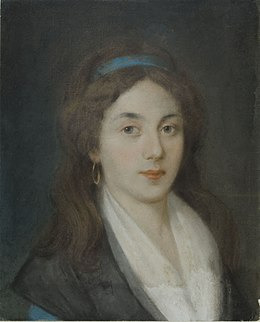



















#frev#french revolution#napoleon#napoleonic era#women in history#haitian revolution#slavery#guadeloupe#frustration
126 notes
·
View notes
Text

Marine Le Pen barred from running for French president
The sentence was delivered after the French far-right icon was found guilty of embezzling European Parliament funds.
Marine Le Pen’s plans to run for the French presidency in 2027 were dealt a likely fatal blow Monday after she was found guilty of embezzling European Parliament funds and deemed ineligible to stand in elections for the next five years.
Given surging support for her far-right National Rally party, 2027 had widely been seen as a potential breakthrough moment for her populist anti-migration agenda, and several polls put her as a strong contender to succeed Emmanuel Macron in the Elysée Palace.
The decision would appear to open the door for Jordan Bardella, the National Rally president and Le Pen’s heir-apparent, to become the flag-bearer for the far right and run for the presidency.
Le Pen and 24 other codefendants were accused of illicitly siphoning European Parliament funds to pay for party employees who seldom or never dealt with affairs in Brussels or Strasbourg. The court estimated that the accused had over 12 years embezzled more than €4 million, €474,000 of which Le Pen was held personally responsible for as an MEP.
All but one of them, an accountant, were found guilty and handed a mix of fines, ineligibility bans and suspended prison sentences. The National Rally party was also found guilty and handed a €2 million fine, though that can be reduced by €1 million if it does not repeat the crime.
The harshest punishment was reserved for Le Pen, as she was convicted of criminal activity both as a former MEP and then running it as party’s ex-president.
Prosecutors took the extraordinary step of asking the three-judge panel presiding over the case to immediately enact Le Pen’s ban on running for office rather than wait until the appeals process has concluded, which is usually the norm in France.
The judges agreed, citing the gravity of Le Pen’s crime. They also fined her €100,000 and sentenced to four years in prison, two of which were suspended — but those penalties could be delayed by a possible appeal.
“Today, it’s not just Marine Le Pen who is unfairly condemned: It’s French democracy that is being executed,” said Bardella.

Bardella and other far-right figures in France and across Europe were quick to condemn the verdict. Some, like Hungarian Prime Minister Viktor Orbán, even weighed in before Le Pen’s sentence was announced. The Kremlin deplored a “violation of democratic norms” and Italy’s far-right Deputy Prime Minister Matteo Salvini condemned the verdict as a “a bad film” and a “declaration of war by Brussels.”
The defendants repeatedly professed their innocence over the course of the 4-month-long trial, but the prosecution presented damning evidence against them — including text messages from one parliamentary assistant who, months after being hired, asked to be introduced to the MEP he was supposedly working for.
Le Pen and the National Rally knew the trial would be a thorn in their side but were relatively sanguine about the process. And the allegations, for now, have done little to affect either Le Pen or the National Rally’s popularity.
The defendants were, however, taken aback when prosecutors in November asked that immediate ineligibility bans of various lengths be handed to all of the defendants.
If Le Pen is unable to successfully appeal the verdict before the next presidential election, the National Rally is likely to look to Bardella, the party’s loyal 29-year-old president, to step in.
Indeed, in a possible prediction of her own departure from the scene, she told the BFMTV network just before the sentence that Bardella had “the capacity to be president of the Republic.”
And while the future of populist nationalism in France has rarely looked brighter than it does today, Bardella’s lack of experience during a high-profile presidential campaign has fueled skepticism — even within his own ranks — about whether he is up to the task.
Daily inspiration. Discover more photos at Just for Books…?
10 notes
·
View notes
Text
Marine Le Pen sentenced to jail. Britain Enacts ‘Two-Tier’ Justice System. The fall of Europe. Putin drafts 160,000 men. Iranian commander threatens US forces. MAHA bravely fights Big Soda
Lioness of Judah Ministry
Apr 01, 2025
French presidential hopeful Marine Le Pen sentenced to jail: As it happened
A Paris court has barred the right-wing politician from taking part in the 2027 election
French and foreign politicians are reacting to sentences handed down on Monday by a Paris court in a case against the right-wing National Rally party (RN) and several of its most prominent figures, including Marine Le Pen, the party’s former leader who currently heads its parliamentary faction. Le Pen and others have been convicted of embezzling EU funds intended for political assistants and face a variety of sentences, including a five-year ban on seeking public office and two years house arrest. Several other defendants have also been sentenced to prison terms of various lengths.
Le Pen blasts sentence as ‘political’
The court has resorted to practices fit for “authoritarian regimes,” the politician has claimed
French presidential hopeful Marine Le Pen has denounced the sentence handed down to her by a Paris court as a “political decision” taken on an “order” of her opponents seeking to prevent her from running in the 2027 elections. The politician was sentenced to four years in prison on embezzlement charges and barred from running for public office for five years. According to the former leader of the National Rally party (RN), the sole purpose of the ruling was to “prevent [her] from participating and being elected in the presidential election,” she told the French broadcaster TF1 on Monday evening.
Le Pen sentence a ‘declaration of war by Brussels’ – Italian deputy PM
The verdict is a “bad film we are also seeing in Romania” Matteo Salvini declared
Italian Deputy Prime Minister Matteo Salvini has condemned the verdict against French presidential hopeful Marine Le Pen as “a declaration of war by Brussels.” Le Pen has been sentenced to four years in prison on embezzlement charges and barred from running for public office for five years, including an upcoming presidential election in 2027. In a post on X on Monday, Salvini compared the outcome of the trial in Paris to the recent barring of independent candidate Calin Georgescu in Romania. ”Those who fear the judgment of the voters often find reassurance in the judgment of the courts,” Salvini said. “A bad film that we are also seeing in other countries such as Romania.”
Le Pen conviction ‘a very big deal’ – Trump
The trial in France has reminded the US president of the event at home, he said
US President Donald Trump has said that the criminal prosecution of French opposition leader Marine Le Pen reminds him of his own legal battles under the Biden administration. On Monday, Le Pen, the ex-leader of the conservative National Rally (RN) party, was sentenced to four years in prison, two of which will be suspended, and was barred from holding public office for five years. The embezzlement conviction effectively bars her from the 2027 presidential race. When asked by reporters in the Oval Office about the verdict, Trump replied, “That’s a very big deal.”
In case you’re wondering why Le Pen is so popular in France:
Two police cars entered an immigrant suburb in Paris and were attacked by dozens of Muslim rioters.
Opposition banned, dissent crushed—"to save democracy."
Britain Enacts ‘Two-Tier’ Justice System, Prioritizing Bail for Ethnic Minorities
Britain’s Ministry of Justice has enacted new sentencing guidelines prioritizing bail for ethnic minorities, transgenders, and women.
The guidelines, issued in January, instruct judges and magistrates to consider the potential “trauma” experienced by suspects from minority backgrounds, fueling more accusations of two-tier policing and justice. Robert Jenrick, Shadow Justice Secretary for the Conservative Party, criticized the move, stating that the endorsement of a potentially biased judicial framework undermined claims of impartiality. “Labour tried to hoodwink the public that they opposed ‘two-tier justice,’ but this proves they are peddling it,” he said.
4 notes
·
View notes
Text


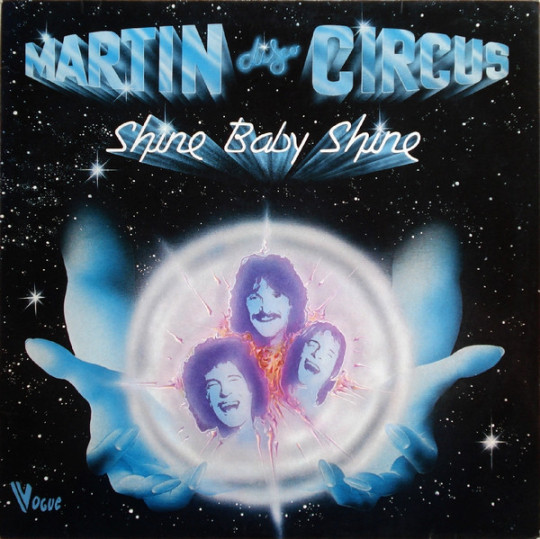

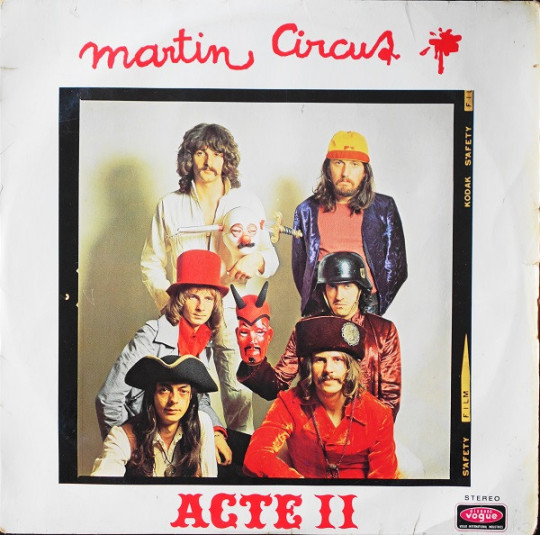







Martin Circus "En Direct Du Rock'n Roll Circus" 1970 + "Acte II" 1971 double LP + "Acte III" 1974 + "N°1 USA Hits Of The 60's"1975 + "Tu Joues Ton Cœur" 1976 + "Rock'n'Roll Circus"1977 + "Martin "Disco" Circus 1978 + "Shine Baby Shine" 1979 + "De Sang Froid"1980 + "Story 69-79" 1994 CD Compilation + "Origines" 2001 + "Evolution Française 1969-1985" 2025 LP Compilation France Psych Prog Pop Rock,Disco,Glam Rock
full
https://open.spotify.com/album/3PbUcUMUeBOGQmJxXtTVZr
full musify
https://musify.club/release/martin-circus-martin-circus-story-1969-1979-1994-855897
https://musify.club/release/martin-circus-tu-joues-ton-coeur-1976-1159150
https://musify.club/release/martin-circus-acte-iii-1974-1739445
https://musify.club/release/martin-circus-shine-baby-shine-1979-1081135
https://musify.club/release/martin-circus-martin-disco-circus-1978-888935
https://musify.club/release/martin-circus-acte-ii-1971-1377540
https://musify.club/release/martin-circus-en-direct-du-rock-n-roll-circus-1970-1082438
Martin Circus is a bit like the French Rubettes. Between pop, rock, disco and variety, they have a string of successes such as the hit that would launch them "Je m'éclate au Sénégal" written by Gérard Pisani, former sax of Johnny Hallyday and Claude François. And yes! the Martin Circus are old hands and have worn out their pants on the benches of the Golf Drouot at the same time as the Black Socks and the Wild Cats. Before Martin Circus, we find all these beautiful people in Alan Jack Civilisation, Capitals or Balthazar. Before Ticky Holgado took care of their career, they released two excellent progressive rock albums. The first is even resolutely pop, even underground, recorded at the Rock'n'Roll Circus, a mecca of counterculture in the 70s. The second will remain in the memory with the unforgettable "Je m'éclate au Sénégal" which manages the feat of being banned from the air on Europe 1. Pierre Delanoë, former program director, found this song distressing, downright useless, unworthy of being broadcast on his airwaves. Another era, the same customs. Then comes the time for covers, starting with the Beach Boys' classics that invite them to the gates of glory. Then it's time for Disco and a track that climbs in the American Billboard. Another feat of arms is their presence in the Musical Comedy (it was called a rock opera at the time...), "The French Revolution" (with Daniel Balavoine, Dani, etc.) and in the cinema, in the film "Les Bidasses en vadrouille" where they replace Les Charlots at short notice. In short, until 1987 and sporadically until 2001, the official date of the end of the band, Martin Circus did not stop surfing on the musical trends of the moment. The result: some great popular successes, no chance of entering the history of French rock, but a reasoned choice for the good management of a bank account. Before Martin Circu The latest version of Alan Jack Civilisation which was released on 45 rpm in French for Alain Pewzner and René Guérin. Balthazar for Sylvain Pauchard and Gérard Blanc. Capitals for Patrick Dietsch who played on the band's only 45 rpm released in 1966. What has become of them? Alain Pewzner and Sylvain Pauchard join Daniel Balavoine on stage and in the studio. Alain Pewzner pursued a career as a "shark" with Jean-Jacques Goldman in particular. Sylvain Pouchard produced tracks for other groups such as Les Avions. He also released a 45 rpm under his name in 1971 with USA/USRR on the B side co-signed with Serge Gainsbourg! A title that can be found in the Martin Circus repertoire in 1980 Gérard Blanc (1948 – 2009) pursued a solo career that would take him to the top of the Top 50 in 1987 with "Une autre histoire". He has also written several titles for Stéphanie of Monaco... They appeared in 2001's Tribute to Trust and a breathtaking cover of "Antisocial". He died of a haemorrhage on 24 January 2009. He was 61 years old. After several 45s in the 70s, Paul-Jean Borowski released 2 albums in quick succession in 1981 and 1982. Patrick Dietsch has three albums to his credit, in 1974 and 1979 for Vogue and again in 2010. He works for Guitarist and Bass Magazine. As for Gérard Pisani, after a few solo attempts, he found himself in 1978 in the pseudo-punk group Bulldozer, where we also met Bob Brault and Paul-Jean Borowski. In 1996, he released a jazz album. Along with Patrick Dietsch and Paul-Jean Borowski, Bob Brault can be seen in the film Camping. They are part of the group that animates the crazy evenings at the Flots Bleus campsite. Bob Brault is also the author of film scores such as Les Sous-Doués pass le bac....~
Martin Circus "En Direct Du Rock'n Roll Circus" 1970
Credits Bass Guitar – Bob Brault Drums – Jean-François Leroy* Flute, Soprano Saxophone, Bugle, Piccolo Flute – Gérard Pisani Guitar – Patrick Dietsch Organ – Paul-Jean Borowski Vocals – Gérard Pisani (tracks: A4, A6, B2, B3, B5, B6), Patrick Dietsch (tracks: A1, A3, A5, A6,), Paul-Jean Borowski* (tracks: A1, A2, A5 to B2, B5, B6) Tracklist La 3ème (Ouverture) 2:50 Moi J'ai Fait La Guerre 3:51 Tout Tremblant De Fièvre 5:25 Tomahawk 2:33 Barbe Bleue 2:50 Moi Je Lis Des Bandes Dessinées 3:00 Le Matin Des Magiciens 3:45 C'est Pas D'la Soupe 2:45 Troïka 4:00 À Quoi Sert Ma Prière 3:40 Nos Larmes Tombaient 5:00 La 3ème (Final) 1:45
Martin Circus "Acte II" 1971 double LP
Credits Bass, Flute, Percussion, Vocals, Narrator – Bob Brault Bugle, Tenor Saxophone, Alto Saxophone, Soprano Saxophone, Clarinet, Flute, Trombone, Percussion – Gerard Pisani* Drums, Violin, Viola, Percussion, Vocals – Rene Guerin* Guitar, Organ, Percussion, Vocals – Alain Pewzner Organ, Piano, Vibraphone, Accordion, Vocals – Sylvain Pauchard Vocals, Guitar, Percussion, Narrator – Gerard Blanc* Tracklist Boudjateelack Pourquoi Tous Ces Cris 6:15 Chevauchée Fantastique 5:04 Poème 8:00 Ti'Bill Poussières 7:05 J'Ai Perdu 6:20 J'Suis Une Groupie 3:52 Ouvrez Vos Mémoires 3:40 Je M'Eclate Au Senegal 4:11 Le Tromblon Magique 4:20 Hyznogod 3:37 Images 2:43 A Dada Sur Paranoïa 4:48 Façon De Parler 7:54 O'Secours Bob 3:50 J'Aimerai Bien Te Faire Flipper Un P'Tit Peu 3:34 Ma Guitare 3:47
Martin Circus "Acte III" 1974
Credits Bass, Flute, Vocals – Bob Brault Drums, Percussion – René Guerin Featuring [Débilités] – Tiki Holgado* Guitar, Vocals – Alain Pewzner Piano, Organ, Keyboards – Sylvain Pauchard Vocals, Guitar – Gérard Blanc Tracklist Docteur 3:36 Fille D'Amour 3:36 Elle Chante Au Soleil 4:08 Je Suis Né Sans Voir 3:49 On Aurait Tout Pour Etre Heureux 4:15 Je T'Aime 3:16 Les Indiens Du Dernier Matin 4:08 La Bossa Blanche 4:18 Un Accident Heureux 3:20 Toi L'Univers 3:00 Les Ballons Nous Emmènent 0:38
Martin Circus " N°1 USA Hits Of The 60's"1975
Tracklist Ma-Ry-Lene 2:39 Judith Sois Discrete 2:50 Prends Le 1er Train 2:57 Un Sourire 3:26 L'amie Des Esprits 2:49 Mets Ton Habit 3:13 Nana - Hey Hey 3:47 Monnaie Monnaie 3:01 Cette Fille Me Rend Fou 2:49 Heureux Tous Les Deux 2:28 Mais Qu'est-ce Que T'as 2:53 Mon 1er Hold Up 2:50
Martin Circus "Tu Joues Ton Cœur" 1976
Tracklist Tu Joues Ton Cœur 3:57 Chicago Dolly 3:37 Priorité A L'amour 3:24 Chasse Mon Blues Au Loin 2:55 C'est Comme Ça 2:21 Direction N.O. 3:26 Si Tu Me Loupes 3:13 Baby Baby Babe 2:38 Ça Rit Ça Pleure 2:48 Vis Ta Vie Ma-Ma-Mie 3:43 Suffit D'un Rien 4:04 L'ami D'un Soir 3:01
Martin Circus "Rock'n'Roll Circus" 1977
Tracklist Rock'n'Roll Circus 5:47 Hey Disc-Jokey 3:48 Roi Du Flipper 2:57 Tu Boudes Mon Téléphone 3:28 Comme Au Bon Vieux Temps Du Rock'n'Roll 3:11 Les Dix Commandements (St Bémol Priez Pour Lui) 4:55 Planche De Skate 2:24 Super Fan Des Rois Du Rock'n'Roll 3:26 Danse Et Tente Ta Chance 3:50 Drague Party (Le Bon Temps Ça Roule) 4:13
Martin Circus "Martin "Disco" Circus 1978
Tracklist Ite Missa Est 6:37 Pour M'En Aller Plus Loin 8:31 Pouêtt 0:22 Disco Circus 14:06 Pouêtt Pouêtt 0:25
Martin Circus "Shine Baby Shine" 1979
Tracklist Number One Woman 4:48 Calling Time 6:28 Each Day 6:07 I've Got A Treat 7:53 Shine Baby Shine 7:01 Happy Ending 5:44
Martin Circus "De Sang Froid"1980
Tracklist Tous Des Robots S.O.S. Aux Galaxies U.S.S.R/U.S.A Bains- Douches Le Tango De L'Espace Arrêtez Tout Banana Baby Tu M'Etranges Plastique Conclusion
Martin Circus "Story 69-79" 1994 CD Compilation
Tracklist Je M' éclate Au Sénégal 4:06 Marylène 2:41 Je Danse Comme Un Pingouin 4:08 Drague Party 3:44 Les Indiens Du P' tit Matin 4:54 Si Tu Me Loupes 3:13 People Réveillez-Vous 4:10 Shine Baby Shine 3:19 Tout Tremblant De Fièvre 3:39 Docteur 3:35 Retour De La Bastille (Français, Français) 1:59 Le Matin Des Magiciens 3:48 J' ai Perdu 6:24 A Dada Sur Paranoïa 4:43 J' aimerai Bien Te Faire Flipper Un P'tit Peu 4:23 Pourquoi Tous Ces Cris 3:43 Ouvrez Vos Mémoires 3:45 Il Faut Rêver 2:57
Martin Circus "Origines" 2001
Tracklist 1 On Aimerait Bien Qu'Ça Change 2 Urgence 3 Je M'Éclate Au Sénégal 4 Tout Tremblant De Fièvre 5 Question De Survie 6 La Planète Des Femmes 7 Vivement Lundi 8 Arc-En-Ciel 9 Nostalgie 10 La Voie Du Milieu 11 Elle Est Pas Belle La Vie 12 Comme Des Dieux 13 Au Même Endroit
Martin Circus " Evolution Française 1969-1985" 2025 LP Compilation
Tracklist Tout Tremblant De Fièvre 3:37 Façon De Parler 6:28 Annie, Christine Ou Patricia 4:05 À Bas Tous Les Privilèges 2:20 Les Indiens Du Dernier Matin 4:10 Mon Premier Hold-Up 2:48 Disco Circus (François K edit) 7:45 Bains Douches 5:06 J'T'Ai Vu Dans Le Canoé 4:42 Pourquoi Tu M'Lâches Pas 4:30
Membres Derniers membres
Alain Pewzner - guitare, orgue, chant (1971-1988, 2001, 2016-2017) Sylvain Pauchard - claviers, basse, chant (1971-1988, 2001, 2016-2017) Tom Bock - chant (2016-2017) Félix Sabal-Lecco - batterie (2016-2017) Anciens membres Bob Brault - basse, flûte (1968-1975, 1988, 2001) Gérard Pisani - saxophone, flute, bugle, chant (1968-1972, 1980, 2001) - († 2020) Paul-Jean Borowsky - claviers, chant (1968-1971, 2001) Patrick Dietsch - guitare, chant (1968-1970, 2001) - († 2021)[11] Jean-François Leroi - batterie (1968-1970) Gérard Blanc - chant, guitare (1971-1987, 2001) - († 2009) René Guérin - batterie, percussions (1971-1978, 1988, 2001) Michel Libretti - guitare, chant (1970) Donald Rieubon - batterie (1970) Charlie Cohen - basse (1978) Serge Haouzi - batterie (1978) Gilles Tinayre - claviers (1978) John Lorck - batterie (1979-1980) Manu Vogel - basse (1980) Pascal Woyciechowski - batterie (1980) Christian Padovan - basse (1985-1986)
Discographie
Album en public 1969 : En direct du rock'n'roll circus (en concert)
Albums studio
1971 : Acte II (double LP)[13] 1974 : Acte III 1975 : N°1 USA - Hits Of The 60's 1976 : Tu joues ton cœur 1977 : Drague Party - Rock'N'Roll Circus 1978 : Disco (bande originale du film Les Bidasses en vadrouille) 1979 : Martin “Disco” Circus (pressage LP US[14]) 1979 : Shine Baby Shine 1980 : De sang froid 1980 : In Cold Blood (pressage LP US) 2001 : Origines
Singles
1969 : Tout tremblant de fièvre (studio) / Barbe-Bleue (studio) 1969 : Le Matin des magiciens (studio) / Moi je lis des bandes dessinées (studio) 1970 : Dis-moi / Chanson pour un cadavre 1971 : Je m’éclate au Sénégal / Moi j’aime bien prendre mon pied 1971 : Sénégal / Dis-moi (pressage italien) 1971 : Je danse comme un pingouin / J’aimerais bien te faire flipper un p’tit peu 1971 : Je m’éclate au Sénégal / Je danse comme un pingouin (pressage allemand) 1972 : Les Indiens du petit matin (part. 1) / Les Indiens du petit matin (part. 2) 1972 : Il faut rêver[15]/ Annie, Christine ou Patricia 1972 : Gotta Keep Flying / Il faut rêver 1973 : Je me suis retrouvé en tutu / Je deviens comme fou fou fou 1973 : People, réveillez-vous / Nous sommes dans ce monde 1973 : La patrie est en danger / Français, Français 1974 : Un coin qui sent le foin / J’aimerais bien t’embrasser 1974 : L’Accident heureux / À vous de jouer Milord 1974 : Docteur / Je t’aime 1975 : Ma-ry-lène / Loin d’ici 1975 : Wonder tube (Ba ! Ba ! Hey ! Hey !) / Ma-ry-lène 1975 : Bye-bye Cherry / Le Violon et la Mélodie 1976 : Si tu me loupes / Un cœur qui bat 1976 : Tu joues ton cœur / Vis ta vie ma ma mie 1976 : Chase the Blues Away / Call Me (pressage allemand) 1977 : Drague Party (Le bon temps, ça roule) / Priorité à l’amour 1977 : Comme au bon vieux temps du rock’n’roll / Roi du flipper 1977 : Les Dix Commandements / Rock’n'roll Circus 1978 : J’en perds mes baskets / Hey disc jockey 1978 : Et puis, tu t’en vas / La Boule à tango 1978 : Pour m’en aller plus loin / Ite missa est 1979 : Disco circus / Ite missa est (pressage canadien) 1979 : Before it gets dark / Disco circus (pressage US) 1979 : Notre meilleur copain, c’est Tintin (vocal) / Notre meilleur copain, c’est Tintin (instrumental) 1979 : Shine Baby Shine / I’ve Got a Treat 1979 : Number One Woman / Each Day 1980 : Look Around / American Trip (pressage italien) 1980 : Bains-douches / Le Tango de l’espace 1980 : Tous des robots / Bains-douches 1980 : USSR / USA / Plastique Conclusion 1981 : Bingo-banco / Mes vœux les plus saints 1983 : Solange / J’t’ai vu dans l’canoë 1984 : Disco Circus / Disco Circus Medley (pressage canadien) 1985 : Trop sentimental / Pourquoi tu m’lâches pas ? 1987 : Je m’éclate au Sénégal / Ma-ry-lène 1987 : Je m’éclate au Sénégal (version 87) / Medley (Intro - Ma-ry-lène - Drague Party (Le bon temps, ça roule) - Si tu me loupes - Shine Baby Shine - Na-na-hey-hey-good-bye - Je m'éclate au Sénégal) 1988 : La Toka-toké (part 1) / La Toka-toké (part 2)
Anthologies
1973 : Tout tremblant de fièvre 1974 : 12 titres + 4 1976 : Greatest Hits : les Grands Succès du... Martin Circus 1979 : Le Double disque d'or du Martin Circus 1979 : Martin Circus chantent leurs succès 1979 : Marylène 1987 : Les Originaux (inclus un titre inédit Columbia signé J-M. Vignon - A. Pewzner - C. Pewzner) 1994 : 69 Story 79 2002 : Singles 69-74 2002 : Ca le fera 2004 : Anthologie 2008 : Les Plus Grands Succès de Gérard Blanc et Martin Circus (inclus cinq morceaux avec Martin Circus et une version solo en live de Je m'éclate au Sénégal)
Martin Circus "En Direct Du Rock'n Roll Circus" 1970 + "Acte II" 1971 double LP + "Acte III" 1974 + "N°1 USA Hits Of The 60's"1975 + "Tu Joues Ton Cœur" 1976 + "Rock'n'Roll Circus"1977 + "Martin "Disco" Circus 1978 + "Shine Baby Shine" 1979 + "De Sang Froid"1980 + "Story 69-79" 1994 CD Compilation + "Origines" 2001 + "Evolution Française 1969-1985" 2025 LP Compilation France Psych Prog Pop Rock,Disco,Glam Rock
https://johnkatsmc5.blogspot.com/2025/03/martin-circus-en-direct-du-rockn-roll.html?view=magazine
https://johnkatsmc5.tumblr.com/post/778813175161405441/martin-circus-en-direct-du-rockn-roll-circus
#Martin Circus “En Direct Du Rock'n Roll Circus”#Martin Circus “ Evolution Française 1969-1985”#Martin Circus “Origines”#Martin Circus “Story 69-79”#Martin Circus “De Sang Froid”#Martin Circus “Shine Baby Shine”#Martin Circus “Martin ”Disco“ Circus#Martin Circus “Rock'n'Roll Circus” 1977#Martin Circus “Tu Joues Ton Cœur”#Martin Circus “ N°1 USA Hits Of The 60's”#Martin Circus “Acte III”#Martin Circus “Acte II”#france pop rock#france progressive rock
2 notes
·
View notes
Text
@mask131 @themousefromfantasyland @the-blue-fairie @professorlehnsherr-almashy @princesssarisa @barbossas-wench @tamisdava2
youtube
youtube
The Wall is a documentary film made in 2011 by Sophie Robert about autism and psychoanalysis.
The alternative full name of the film is The Wall or psychoanalysis put to the test on autism.
The film considers the question of whether psychoanalysis is a suitable treatment for autism.
The film argues that while the rest of the world considers autism as a neurological disorder caused by anomalies in a specific area of the brain, in France concepts of the condition remain dominated by psychoanalysis, which sees autism as a form of psychosis caused by difficulties in subjective relationships and ultimately caused by the actions of the mother. The film relies on extensive interviews with 11 French psychoanalysts in order to tease out the details of their beliefs, which the film contrasts with the progress made by children who follow other, behavioural, approaches to improving autistic children's ability to communicate.
The film argues that the psychoanalytic approach to autism is based on ignorance and misogyny and leads to harmful consequences for autistic children who fall under the care of psychoanalysts.
The film ends with Robert asking the psychoanalysts what an autistic child can realistically expect to gain from a psychoanalytic therapy; the psychoanalysts interviewed are shown not to be able to answer this question coherently.
Three of the psychoanalysts interviewed in the film sued Ms Robert. The three plaintiffs (Eric Laurent, Esthela Solano, and Alexandre Stevens) expressed the view that they hold intellectual property rights to the footage filmed by Ms Roberts and that she edited it without their consent and thus distorted their comments.
The court (Lille Regional Court) found against Robert thus banning the film. However this ban was overturned by a court of appeal in 2014.
The appeal court found that while Robert may have misled the psychoanalysts as to the editorial line her film would take, she had not materially misrepresented their views in her editing of the footage.
As of 2016 the film is available for viewing online.
7 notes
·
View notes
Video
youtube
Jane Mallory Birkin (14 December 1946 – 16 July 2023)
Jane Mallory Birkin was born in London in December 1946, daughter of British actress Judy Campbell and Royal Navy commander David Birkin.
She had lived in her adopted France since the late 1960s and apart from her singing and roles in dozens of films, she was a popular figure for her warm nature, stalwart fight for women's and LGBT rights.
She first took to the stage aged 17 and went on to appear in the 1965 musical "Passion Flower Hotel" by conductor and composer John Barry, whom she married shortly after. The marriage ended in the late 1960s.
Before venturing across the Channel aged 22, she achieved notoriety in the controversial 1966 Michelangelo Antonioni film "Blow-Up", appearing naked in a threesome sex scene.
But it was in France that she truly shot to fame, as much for her love affair with tormented national star Gainsbourg, as for her tomboyish style and endearing British accent when speaking French.
It was on the set of the film "Slogan" in 1969 that Birkin first met Gainsbourg, who was recovering from a break-up with Brigitte Bardot, and the two quickly began a love affair that captivated the nation.
That same year they released "Je T'Aime... Moi Non Plus" ("I Love You... Me Neither"), a song about physical love originally written for Bardot in which Gainsbourg's explicit lyrics are punctuated with breathy moans and cries from Birkin.
The song was banned by the BBC and condemned by the Vatican.
Following the breakup of that relationship in 1981, she continued her career as a singer and actress, appearing on stage and releasing albums such as "Baby Alone in Babylone" in 1983, and "Amour des Feintes" in 1990, both with words and music by Gainsbourg.
Gainsbourg's drinking eventually got the better of the relationship, and Birkin left him in 1981 to live with film director Jacques Doillon. However she remained close to the troubled singer until his death in March 1991.
It was around this time that she inspired the famous Birkin bag by French luxury house Hermes, after chief executive Jean-Louis Dumas saw her struggling with her straw bag on a flight to London, spilling the contents over the floor.
She wrote her own album "Arabesque" in 2002, and in 2009 released a collection of live recordings, "Jane at the Palace".
She is survived by two daughters the singer and actress Charlotte, born in 1971, and Lou Doillon, also an actress, born in 1982. She also had a daughter, Kate, who was born in 1967 and died in 2013.
(Reporting by John Irish Editing by David Goodman and Frances Kerry)
(Jane Birkin & Serge Gainsbourg - Je T'aime,...Moi Non Plus)
Rest in peace to the Timeless Style Icon and Epitome of Effortless Chic
#youtube#art#music#70s#icon#jane birkin#rip#rip jane birkin#charlotte gainsbourg#serge gainsbourg#singer#actress#uk#jacques doillon#fashion#modelsdot#lu legend#kamen rider#je t'aime moi non plus#hermes#john barry#blow-up#chic#timeless#style icon#la piscine#alain delon#romy schneider#movies
52 notes
·
View notes
Text
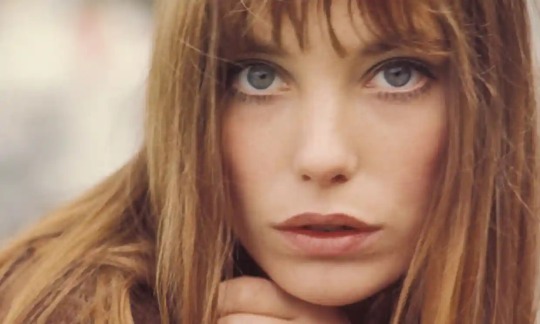
Jane Birkin, actor and singer, dies aged 76
Best known for the sexually explicit 1969 hit Je t’aime … moi non plus, she found fame in her adopted France
The British-born actor and singer Jane Birkin has been found dead at her home in Paris, the French culture ministry said on Sunday.
Birken, 76, was best known overseas for her 1969 hit in which she and her lover, the late French singer-songwriter Serge Gainsbourg, sang the sexually explicit Je t’aime … moi non plus.
Birkin found fame in her adopted France, catapulted into the public eye by her turbulent relationship with Gainsbourg. Her heavily accented French became her personal style signifier.
She crossed the channel in 1968 at the age of 22 to star in a film alongside Gainsbourg, who was 18 years her senior. It was the start of a 13-year relationship that made them France’s most famous couple, in the spotlight as much for their bohemian and hedonistic lifestyle as for their work.
The doe-eyed Birkin, with her soft voice and androgynous silhouette, quickly became a sex symbol, recording the steamy Je t’aime … moi non plus with a growling Gainsbourg. Banned on radio in several countries and condemned by the Vatican, the song was a worldwide success.
“He and I became the most famous of couples in that strange way because of Je t’aime and because we stuck together for 13 years and he went on being my friend until the day he died. Who could ask for more?” Birkin told CNN in 2006.
“So Paris became my home. I’ve been adopted here. They like my accent,” she said.
Birkin was born in London on 14 December 1946 to an actor mother and naval officer father. At 17, she married the James Bond composer John Barry, with whom she had a daughter, Kate, but the marriage lasted only three years.
She made waves in her film debut in 1966 with a full frontal nude scene in the swinging sixties classic Blow-Up by Michelangelo Antonioni.
After meeting Gainsbourg, 18 years her senior, in Paris on the set of a romantic comedy – he was her co-star – she moved to France permanently. Their musical and romantic relationship was tempestuous. During one of their raging rows, Birkin launched herself into the River Seine after throwing a custard pie in Gainsbourg’s face.
They had a daughter, Charlotte, who became a hugely successful actor and singer.
Birkin finally walked out on France’s favourite bad boy in 1980 and went on to to blaze her own trail. In cinema, she branched out from more ditsy roles to arthouse productions, gaining three nominations at the Césars – France’s Oscars – starting with La Pirate in 1985.
In her about 70 films she has been directed by France’s leading directors, including Bertrand Tavernier, Jean-Luc Godard, Alain Resnais, James Ivory and Agnès Varda.

A chronic alcoholic, Gainsbourg died of a heart attack in 1991 aged 62. A few years earlier, he was in the audience to hear Birkin perform her first solo concert at the age of 40 at the Bataclan theatre in Paris.
In 1998 came her first record without Gainsbourg, Á la Légère. But she repeatedly returned to his repertoire, singing his hits around the world accompanied by a full orchestra, including in 2020 in New York where she performed with Iggy Pop.
The English rose of French chanson became something of a national treasure, who preserved the accent that made the French swoon throughout her life and an endearing air of fragility.
Her life was marked by tragedy, with her eldest daughter Kate Barry, a photographer, apparently committing suicide in 2013. She had leukaemia in the late 1990s and in 2021 suffered a minor stroke.
With her flared jeans, mini-dresses and messy bangs, Birkin was the ultimate It girl in the 1970s. In 1984, Hermès named one of its handbags after her. She was made an Officer of the Order of the British Empire (OBE) in 2001 for her services to acting and British-French cultural relations.
Besides Charlotte and Kate, she had another daughter, the singer Lou Doillon, from her 13-year relationship with the French director Jacques Doillon.
RIP Jane
27 notes
·
View notes
Text
PARIS — Marine Le Pen has her own nickname for the Brussels bubble.
The far-right French leader likes to call the close-knit circle of lawmakers, lobbyists and civil servants working in the European Union capital “the Blob”
The reference is to the 1958 science fiction film in which a ravenous, gelatinous mass expands as it consumes everything in its path. It was an image Le Pen deployed this week, as she tried to turn a legal ordeal into a political opportunity.
The long-standing presidential candidate is facing trial, along with 26 others, accused of embezzling millions of euros in European Parliament funds by using them to pay staffers to do domestic politics instead of their work as parliamentary assistants. Her party, as a legal entity, is also facing charges.
During five hours of testimony earlier this week, Le Pen sought to turn the tables on the Parliament, describing it as an organ that co-opts its members, cutting them off from the citizens they are supposed to represent.
Or, as she put it, MEPs risk being absorbed by the Blob.
“The European Parliament works in such a way that it swallows up the MEPs,” she claimed. “Everything is available within the European Parliament: You can sleep in, get your hair done, go to the bookshop … Everything is done so that MEPs can live within the European Parliament.”
“The role of the party is to remind them to also engage in politics,” she added.
For Le Pen, the stakes are immense. She plans to run in the 2027 presidential election and is leading in the polls. If convicted, she faces a maximum sentence of 10 years in prison, a fine of up to €1 million and a possible five-year ban from public office.
The case alleges a scheme of misdirected funds that took place between 2004 and 2016. Central to the charges against Le Pen is her former assistant Catherine Griset.
Griset worked for Le Pen for nearly 25 years before becoming an MEP in 2019. Prosecutors accused her of doing work for Le Pen’s party in Paris while being paid as the far-right leader’s parliamentary assistant.
According to the prosecutors, during one period Griset spent 15 to 22 days a month at the party’s headquarters in Paris instead of the Parliament premises in Brussels and Strasbourg.
After investigators described how Griset only badged into the parliament for about 12 hours between October 2014 and August 2015, Le Pen answered saying that this was because Griset would enter the building as part of her entourage, with the security staff greeting them with “wide smiles.”
When Didier Klethi, director general of the Parliament, stated that only MEPs — not their assistants — could enter the premises without presenting a badge, Le Pen pushed back, suggesting that the Parliament’s administration might have been upset by the friendliness of the security staff to her Euroskeptic party’s members.
On Tuesday, Griset defended herself, insisting she “never worked for the party” but only for Le Pen. But she struggled to address key points, particularly regarding her time spent in Brussels. Griset acknowledged that she stayed in Belgium for only two nights a week, despite her contract requiring full-time residency.
In her testimony, Le Pen — one of France’s most prominent critics of the EU — challenged the premise of the charges, a tactic more likely to sway her supporters than the judges hearing the case.
She argued it was wrong to separate the work an MEP does as an elected official from their party responsibilities — and that it was thus legitimate for their assistants to help with both.
“I believe that members of parliament work to further their ideas,” she said. Participation in party activities, media appearances and “convincing new voters,” she argued, are part of an MEP’s responsibilities.
As to the time Griset spent in Paris, French MEPs should “defend French interests,” Le Pen said.
“Others consider that the European Parliament is a political body in itself,” she added. “This is not our vision.”
2 notes
·
View notes
Text
Cate Blanchett named son after convicted child sex offender Roman Polanski | news.com.au — Australia’s leading news site
https://www.news.com.au/entertainment/celebrity-life/cate-blanchett-named-son-after-convicted-child-sex-offender-roman-polanski/news-story/7643a75ab10a08d35b781b1f07043c59#:~:text=Blanchett%20said%20Roman%20was%20named,famous%20American%20novelist)%20Dashiell%20Hammett.
https://ohnotheydidnt.livejournal.com/98319492.html
Blanchett said Roman was named after the disgraced director, who fled the United States in 1978 before he was due to be sentenced for having unlawful sexual intercourse with a minor.
“You run out of ideas by the time you get to number three,” she joked.
“Dashiell came from (famous American novelist) Dashiell Hammett.
“Roman, I don’t know... Polanski. But it’s also the French word for book.”
Polanski has been living in exile in France since 1978, despite multiple attempts by the United States to extradite him.
Blanchett previously came under fire in 2014 after starring in Woody Allen’s film Blue Jasmine.
Allen’s daughter Dylan Farrow wrote an open letter to Blanchett, criticising her for working with the director despite her claims of child sexual abuse.
Tough love ... Cate won an Oscar for Blue Jasmine despite being criticised for working with Woody Allen. Picture: Kevin Winter/Getty Images
Tough love ... Cate won an Oscar for Blue Jasmine despite being criticised for working with Woody Allen. Picture: Kevin Winter/Getty Images
“What if it had been your child, Cate Blanchett? Louis CK? Alec Baldwin? What if it had been you, Emma Stone? Or you, Scarlett Johansson? You knew me when I was a little girl, Diane Keaton. Have you forgotten me?” she wrote.
In response, Blanchett said it had “obviously been a long and painful situation for the family and I hope they find some resolution and peace”.
Roman Polanski
youtube

Ignatius, Captain Underpants
"According to the American Library Association, the Captain Underpants books were reported as some of the most banned and challenged books in the United States between 2000 and 2009 as well as between 2010 and 2019. The books were named one of the top ten most banned and challenged books in 2002, 2004, 2005, 2012, 2013 and 2018.
The Captain Underpants series was explicitly banned in some schools for "insensitivity, offensive language, encouraging disruptive behavior, LGBTQIA+ issues, violence, being unsuited to the age group, sexually explicit content, anti-family content, as well as encouraging children to disobey authority."
Dashiell Hammett....
Hammett devoted much of his life to left-wing activism. He was a strong antifascist throughout the 1930s, and in 1937 joined the Communist Party. On May 1, 1935, Hammett joined the League of American Writers (1935–1943), whose members included Lillian Hellman, Alexander Trachtenberg of International Publishers, Frank Folsom, Louis Untermeyer, I. F. Stone, Myra Page, Millen Brand, Clifford Odets, and Arthur Miller. (Members were largely either Communist Party members or fellow travelers. He suspended his anti-fascist activities when, as a member (and in 1941 president) of the League of American Writers, he served on its Keep America Out of War Committee in January 1940 during the period of the Molotov–Ribbentrop Pact.
Especially in Red Harvest, literary scholars have seen a Marxist critique of the social system. One Hammett biographer, Richard Layman, calls such interpretations "imaginative", but he nonetheless objects to them, since, among other reasons, no "masses of politically dispossessed people" are in this novel. Herbert Ruhm found that contemporary left-wing media already viewed Hammett's writing with skepticism, "perhaps because his work suggests no solution: no mass-action... no individual salvation... no Emersonian reconciliation and transcendence".
In a letter of November 25, 1937, to his daughter Mary, Hammett referred to himself and others as "we reds". He confirmed, "in a democracy all men are supposed to have an equal say in their government", but added that "their equality need not go beyond that." He also found, "under socialism there is not necessarily... any leveling of incomes."
Hellman wrote that Hammett was "most certainly" a Marxist, though a "very critical Marxist" who was "often contemptuous of the Soviet Union" and "bitingly sharp about the American Communist Party", to which he was nevertheless loyal.
At the beginning of 1942, he wrote the screenplay of Watch on the Rhine, based on Hellman's successful play, which received a nomination for the Academy Award for Best Writing (Adapted Screenplay). But that year the Oscar went to Casablanca. In early 1942, following the attack on Pearl Harbor, Hammett again enlisted in the United States Army. Because he was 48 years old, had tuberculosis, and was a Communist, Hammett later stated he had "a hell of a time" being inducted into the Army. However, biographer Diane Johnson suggests that confusion over Hammett's forename was the reason he was able to re-enlist. He served as an enlisted man in the Aleutian Islands and initially worked on cryptanalysis on the island of Umnak. For fear of his radical tendencies, he was transferred to the Headquarters Company where he edited an Army newspaper entitled The Adakian. In 1943, while still a member of the military, he co-authored The Battle of the Aleutians with Cpl. Robert Colodny, under the direction of an infantry intelligence officer, Major Henry W. Hall. While in the Aleutians, he developed emphysema.
After the war, Hammett returned to political activism, "but he played that role with less fervour than before". He was elected president of the Civil Rights Congress (CRC) on June 5, 1946, at a meeting held at the Hotel Diplomat in New York City, and "devoted the largest portion of his working time to CRC activities".
In 1946, a bail fund was created by the CRC "to be used at the discretion of three trustees to gain the release of defendants arrested for political reasons." The trustees were Hammett, who was chairman, Robert W. Dunn, and Frederick Vanderbilt Field.
The CRC was designated a Communist front group by the US Attorney General. Hammett endorsed Henry A. Wallace in the 1948 United States presidential election..."


'Blanchett and Stewart joined fellow Cannes jury members, Ava DuVernay, Khadja Nin, and Léa Seydoux, in the South of France for the start of this year's festival earlier this week. Not only did we see both Blanchett and Stewart donning spring-inspired pantsuits we now need in our lives, but we were, more importantly, blessed with photos of Stewart staring tenderly at Blanchett. What a time to be alive."
#Cate Blanchett#Roman Polanski#Ignatius Captain Underpants#Dashiell Hammett Communist and Marxist#Marxism is Satanic#Hollywood#Satanic Cult of Scientology#Hard Leftism#Nihilism#Queer Politics#Transgender language was hidden in Captain Underpants#Youtube#Krusten Stewart#Cannes#Honestly I do like Cate Blanchett as an actor but can't admire her as a person outside of her Art
4 notes
·
View notes
Text

The sultry 1969 hit single Je T’aime … Moi Non Plus was a four-and-a-half-minute distillation of languid Gallic cool, in which a Frenchman, his voice coarsened by Gitanes, is heard billing and cooing with an ecstatically sighing young Englishwoman over the swirling motif of a baroque organ. That man was Serge Gainsbourg; his companion was Jane Birkin, the actor and singer, who has died aged 76. Though Birkin worked with some of the world’s finest film-makers, including Jacques Rivette and Agnès Varda, she knew that Je T’aime … would be remembered above everything else she did. “When I die, that’ll be the tune they play, as I go out feet first,” she said.
Birkin was 21 when she and Gainsbourg met while starring together in the film Slogan (1969). He was 40, and had previously recorded Je T’aime … as a duet with Brigitte Bardot, only for the actor to withdraw permission for it to be released. Birkin had already starred in a 1965 musical, Passion Flower Hotel, scored by John Barry, whom she married that year at the age of 19 and from whom she was divorced in 1968; he was the father of Kate, the first of Birkin’s three daughters. But it was on the duet with Gainsbourg, she said, that for the first time “somebody thought I had a pretty voice”.
She sang her part an octave higher than Bardot. “It gave it a choirboy side that [Gainsbourg] liked a lot,” she said. Rumor's that the vocal track was recorded under the covers during a moment of intimacy were untrue (the couple were standing at separate microphones in a studio in central London) though they did nothing to harm the mythology surrounding a song that was later condemned by the Vatican. “I just remember thinking it was all terribly funny,” she said.
Among the countries that refused to give the song airplay was Britain, where it became the first banned single to reach the top of the charts, as well as the first non-English-language No 1. It was also the lead track on the 1969 album Jane Birkin/Serge Gainsbourg.
Birkin’s life remained inextricably linked to his. They were together for 11 years, and had a daughter, Charlotte, who became a successful singer and actor. Even after they separated in 1980, he continued to write for her, and she went on performing his songs for the rest of her life.
Far from being an adjunct to Gainsbourg’s legend, she possessed her own style, intelligence and attitude. Her wistful beauty was rendered unorthodox by an eager, gap-toothed smile. Her voice was as bewitching as her face: though she lived in France from 1969 onwards, and spoke French fluently, she never shed her breathy, crisply English accent.
She was born in London to Judy Campbell, an actor who had been a muse to Noël Coward, and David Birkin, who was a lieutenant commander in the Royal Navy and a spy during the second world war. His duties included taking British spies across the Channel to France and bringing back stranded airmen and escaped prisoners of war.
Jane was educated at Upper Chine school on the Isle of Wight. At 17 she starred with Ralph Richardson in Graham Greene’s play Carving a Statue; Greene himself had a hand in casting her. Her screen acting career began with a walk-on part in The Knack … and How to Get It (1965) and a controversial nude scene in Michelangelo Antonioni’s Blow-Up, which she agreed to because Barry had told her she wouldn’t dare.
She had a small role in the Warren Beatty caper Kaleidoscope (also 1966), played a model called Penny Lane in the psychedelic curiosity Wonderwall (1968) and starred with Romy Schneider and Alain Delon in the psychological thriller La Piscine (1969). She got on famously with Bardot when they starred together in Don Juan, or If Don Juan Were a Woman (1973). Gainsbourg directed her in a 1976 film named after their hit song; he cast her as a boyish woman who attracts the attentions of a gay man, played by the Warhol regular Joe Dallesandro.
Birkin was tremendous fun in two star-studded Agatha Christie thrillers, Death on the Nile (1978) and Evil Under the Sun (1982). In the cryptic Love on the Ground (1984), Rivette cast her and Geraldine Chaplin as actors drawn into a playwright’s mysterious world. She appeared in two films, The Pirate (1984) and Comedy! (1987), made by her then partner, Jacques Doillon, with whom she had her third daughter, Lou, also a singer and actor. Jean-Luc Godard directed her in Keep Your Right Up (also 1987), while for Varda she played a woman besotted with a 14-year-old boy in Kung-Fu Master! (1988); the film co-starred Charlotte and featured Lou, and was inspired by an idea by Birkin herself.
In the same year, Varda made her the subject of Jane B For Agnès V, in which the actor performed a variety of specially scripted scenes (in one, she was a Stan Laurel type, in another a cockney mother) interspersed with musings on her life. She received the documentary treatment once again when her daughter directed Jane By Charlotte (2021).
Her two most impressive performances came in Bertrand Tavernier’s These Foolish Things, aka Daddy Nostalgie (1990), in which she was moving as a woman trying to repair her relationship with her dying father (Dirk Bogarde); and La Belle Noiseuse (1991), Rivette’s spellbinding four-hour study of a painter (Michel Piccoli) and his new muse (Emmanuelle Béart), in which Birkin played the artist’s wife and former model, who must deal with the indignity of having her younger self literally painted over.
Later films included Alain Resnais’s musical On Connaît la Chanson (1997) and the Merchant-Ivory coming-of-age story A Soldier’s Daughter Never Cries (1998).
In 2002 Birkin was diagnosed with leukaemia, but by 2006 she had made her directorial debut with the autobiographical family drama Boxes, which she also wrote and starred in, along with Chaplin, Piccoli, John Hurt and her daughter Lou. She appeared in Rivette’s final film, Around a Small Mountain (2009), played herself in Hong Sang-soo’s Nobody’s Daughter Haewon, and was reunited with Tavernier for his comedy The French Minister (also 2013).
Her look had been widely applauded in the 1960s, and seemed never to go out of date. In the 80s Hermès introduced a large and exorbitantly priced leather bag, named “the Birkin” in her honour. Fashion journalists in recent years could still be heard celebrating the “Jane Birkin top”, referring to the white lace dress made famous by her in the late 60s. “Real life was what I was best at,” she told Vogue magazine in 2016. “I didn’t have confidence in movie cameras or on stage. But I did have confidence in what I wanted in real life. If I wanted to be barefoot and wear a mackintosh, I would do it. I didn’t give a hoot.”
It was at 40 that she finally discarded her youthful ingénue image and performed her first live concert: “I cut my hair off like a boy, I wore men’s clothes. I only wanted people to hear the music and words. It was fantastic. And it was so frightening. Serge was there and he kept lighting his cigarette lighter to make everybody put their lighters on.” That show was preserved on her 1987 album, Jane Birkin au Bataclan. She continued singing and recording into her old age; among her later albums is Birkin/Gainsbourg: Le Symphonique, from 2017, in which the couple’s songs received new orchestral arrangements.
In 2020 she published Munkey Diaries 1957-1982, containing diary entries addressed to her favourite cuddly toy from childhood, which she can be seen clutching on the cover of Gainsbourg’s 1971 album Histoire de Melody Nelson. She buried the toy with him after his death in 1991.
She is survived by Charlotte and Lou, and six grandchildren, and by her brother, Andrew, and sister, Linda. Kate, a photographer, died in 2013.
🔔 Jane Mallory Birkin, actor and singer, born 14 December 1946; died 16 July 2023
Daily inspiration. Discover more photos at http://justforbooks.tumblr.com
94 notes
·
View notes
Text
Holidays 9.18
Holidays
Aging Awareness Day
Astronomy Day (Armenia)
Big Brothers Big Sisters Day (Canada)
Celebrate Your Name Day
Celebration of Talent (French Republic)
Chiropractic Founders Day
Clemente Day
Day of National Music (Azerbaijan)
Deceased Motorcyclists Remembrance Day (Ukraine)
Dieciocho (Chile)
Eleven Days of Global Unity, Day 8: Human Rights
European Heritage Days (EU)
Feast Day of the Walloon Region (Belgium)
Festival of Inner Worlds
Festival of Labour (French Republic)
Fiesta Patrias (Chile)
First Love Day
Global Company Culture Day
Hug a Greeting Card Writer Day
International Equal Pay Day (UN)
International Pitt Hopkins Awareness Day
International Read an eBook Day
Island Language Day (Okinawa, Japan)
Jeannie in a Bottle Day
Jitiya Parwa (Only Women Employees; Nepal)
Jonny Quest Day
Long Playing Record Day
Mickey Mantle Day (New York)
Mid-Autumn Festival Holiday (Taiwan)
Mountain Meadows Massacre Anniversary Day (by Mormon Church Members; Utah)
Mukden Incident Anniversary Day
National Cannabis Day (Germany)
National Ceiling Fan Day
National Colton Day
National Day of Civic Hacking
National Fitness Day (UK)
National HIV/AIDS and Aging Awareness Day
National Museum Day [also 5.18]
National Music Day (Azerbaijan)
National Play-Dough Day
National Rehabilitation Day
National Report Kickback Fraud Day
National Respect! Day
National Science Reading Day
National Tree Day (Canada)
Navy Day (Croatia)
New York Times Day
918 Day (Oklahoma)
Persian Literature and Pony Day (Iran)
PCOS Awareness Day
Scouring of the White Horse (Wantage, Berkshire, UK)
Shima-kutuba Day (Japan; Okinawa)
Top Ten List Day
U.S. Air Force Day
Victory of Uprona (Burgundy)
Vulver Awareness Day
World Bamboo Day
World Knot Tying Day
World Medical Ethics Day
World Water Monitoring Day
Food & Drink Celebrations
National Brett Day
National Cheeseburger Day
National Chocolate Day
Rice Krispies Treats Day
Independence & Related Days
Buddie Union (Declared; 2015) [unrecognized]
Chile (a.k.a. Dieciocho, 1st Gov't Junta, 1818)
Free Republic of Silbervia (Declared; 2020) [unrecognized]
3rd Wednesday in September
Banned Websites Awareness Day [3rd Wednesday]
Ember Day (Roman Catholic and Anglican Churches) [Wednesday after 9.14]
Human Resource Manager Day [3rd Wednesday]
Hump Day [Every Wednesday]
Mouth Cancer Awareness Day (Ireland) [3rd Wednesday]
National Attention Deficit Disorder Awareness Day [3rd Wednesday]
National Rehabilitation Day [3rd Wednesday]
National School Backpack Awareness Day [3rd Wednesday]
Quarter Tense (Ireland) [Wednesday after 9.14]
Wacky Wednesday [Every Wednesday]
Wandering Wednesday [3rd Wednesday of Each Month]
Website Wednesday [Every Wednesday]
Wiener Wednesday [3rd Wednesday of Each Month]
Weekly Holidays beginning September 18 (3rd Full Week of September)
Wear Cotton Week (thru 9.25)
Festivals Beginning September 18, 2024
Eurofurence (Hamburg, Germany) [thru 9.21]
Festival du Film Merveilleux et Imaginaire (Paris, France) [thru 9.20]
Lost Lands (Thornville, Ohio) [thru 9.22]
National Cattle Congress (Waterloo, Iowa) [thru 9.22]
Walnut Valley Festival (Winfield, Kansas) [thru 9.22]
Feast Days
Amoeba Assimilation Day (Pastafarian)
Anton Mauve (Artology)
Arcadius, Bishop of Novgorod (Christian; Saint)
Ariadne of Phrygia (Christian; Martyr)
Bidzin, Elizbar, and Shalva, Princes of Georgia (Christian; Martyrs)
Cassius Marcellus Coolidge (Artology)
Castor of Alexandria (Christian; Martyr)
Constantius (Theban Legion)
Ear Wig Fitting Day (Shamanism)
Edward Bouverie Pusey (Episcopal Church)
Eleusinian Mysteries begin (Ancient Rome; Starza Pagan Book of Days)
Eugene’s, Bishop of Gortyna (Christian; Saint)
Eustorgius I (Christian; Saint)
Ferreol (Christian; Saint)
Feast of Ceres (Roman Goddess of Agriculture & Grain Crops)
Festival of Labour (French Republic)
Foundation Day (Unification Church)
Hilarion of Optima (Christian; Saint)
Joe Kubert (Artology)
John Harvey Kellogg Day (Church of the SubGenius; Saint)
José de Rivera (Artology)
Joseph of Cupertino (Christian; Martyr)
Juan Macias (Christian; Saint)
Konstantin Kakanias (Artology)
Leonardo da Crunchy (Muppetism)
Lord Berners (Artology)
Lynn Abbey (Writerism)
Mark di Suvero (Artology)
Methodius of Olympus (Christian; Saint)
Plataia (Ancient Greece)
Richardis (Christian; Saint)
Rosmerta (Celtic Book of Days)
Samuel Johnson (Writerism)
Scouring the White Horse begins (Everyday Wicca)
Sophia and Irene of Egypt (Christian; Martyrs)
Third Nostril of Christ Day (Church of the SubGenius)
Thomas of Villanova (Christian; Saint)
Tzom Gedaliah (Fast of Gedalia; Judaism)
Vanaheim Day (Pagan)
Vondel (Positivist; Saint)
Zay Day (Sus God Zay) [Wear red or purple hoodies]
Lunar Calendar Holidays
Chong Chao (Macau)
Chusok (South Korea)
Lucky & Unlucky Days
Fortunate Day (Pagan) [38 of 53]
Taian (大安 Japan) [Lucky all day.]
Tycho Brahe Unlucky Day (Scandinavia) [31 of 37]
Unglückstage (Unlucky Day; Pennsylvania Dutch) [24 of 30]
Unlucky 18th (Philippines) [3 of 3]
Premieres
Abacab, by Genesis (Album; 1981)
Abou Ben Boogie (Swing Symphony Cartoon; 1944)
The Addams Family (TV Series; 1964)
Birthday, recorded by The Beatles (Song; 1967)
A Bully Frog (Terrytoons Cartoon; 1936)
Cat on a Hot Tin Roof (Film; 1958)
Cloudy with a Chance of Meatballs (Animated Film; 2009)
Continental Divide (Film; 1981)
Crazytown (Noveltoons Cartoon; 1959)
The Day the Earth Stood Still (Film; 1951)
Dog Daze (WB MM Cartoon; 1937)
Enough Said (Film; 2013)
The Farm of Tomorrow (MGM Cartoon; 1954)
Fatal Attraction (Film; 1987)
Five and Dime (Oswald the Lucky Rabbit Cartoon; 1933)
The French Lieutenant’s Woman (Film; 1981)
Funny Girl (Film; 1968)
Gene Simmons, Paul Stanley, Ace Frehley, and Peter Criss (Albums; 1978)
Get Smart (TV Series; 1965)
Goldfinger premiered in UK (1964) [James Bond #3]
Goo Goo Goliath (WB MM Cartoon; 1954)
The Gullible Canary (Phantasies Cartoon; 1942)
Hair Today Gone Tomorrow (Noveltoons Cartoon; 1959)
Heartache Tonight, by The Eagles (Song; 1979)
I Likes Babies and Infanks (Fleischer Cartoon Popeye Cartoon; 1937)
In the Night Kitchen, by Maurice Sendak (Children’s Book; 1970)
The Japoteurs (Fleischer Cartoon; 1942) [#10]
Jennifer’s Body (Film; 2009)
Jonny Quest (Animated TV Series; 1964)
Making Money, by Terry Pratchet (Novel; 2007) [Discworld #36]
Maple Leaf Rag, by Scott Joplin (Song; 1899)
Maze Runner: The Scorch Trials (Film; 2015)
The Moffatt Translation of the Bible (Bible; 1922)
More Than a Feeling,, by Boston (Song; 1976)
New York Times (Daily Newspaper; 1851)
Old Rockin’ Chair Tom (Tom & Jerry Cartoon; 1948)
Pain Strikes Underdog, Parts 1 & 2 (Underdog Cartoon, S2, Eps. 1 & 2 1965)
Pink in the Clink (Pink Panther Cartoon; 1968)
The Road to Ruin or Mine Over Matter (Rocky & Bullwinkle Cartoon, S2, Ep. 55; 1960)
Rockin’ with Judy Jetson (Hanna-Barbera Animated TV Movie; 1988)
Rush Hour (Film; 1998)
School Daze (Terrytoons Cartoon; 1942)
The Scorch Trials, by James Dashner (Novel; 2010) [Maze Runner #2]
Serve It Forth (Art of Eating), by M.F.K. Fisher (Food Essays; 1937)
Severed Relations or How to Get a Head (Rocky & Bullwinkle Cartoon, S4, Ep. 161; 1962)
Sicario (Film; 2015)
Singles (Film; 1992)
Smiley Smile, by The Beach Boys (Album; 1967)
Strange Little Girl, by Tori Amos (Album; 2001)
A Streetcar Named Desire (Film; 1951)
Studio 60 on the Sunset Strip (TV Series; 2006)
Superman: Doomsday (WB Animated Film; 2007)
That’s the Way the Cookie Crumbles or Me and My Chateau (Rocky & Bullwinkle Cartoon, S4, Ep. 162; 1962)
Tired and Feathered (WB LT Cartoon; 1965)
Two Flying Ghosts or High Spirits (Rocky & Bullwinkle Cartoon, S2, Ep. 56; 1960)
Wagon Train (TV Series; 1957)
War Pigs, by Black Sabbath (Song; 1970)
Where’s Wally, by Martin Hanford (Puzzle Book; 1987)
WKRP in Cincinnati (TV Series; 1978)
Today’s Name Days
Herlinda, Josef, Lambert, Rica (Austria)
Alfonz, Irena, Jonatan, Josip, Sonja (Croatia)
Kryštof, Oskar (Czech Republic)
Titus (Denmark)
Tiido, Tiidrik, Tiidu, Tiit (Estonia)
Tytti, Tyyne, Tyyni (Finland)
Nadège, Véra (France)
Alfons, Herlinde, Lambert, Rica (Germany)
Ariadne, Ariadni, Evmenis, Kastor, Romylos (Greece)
Diána (Hungary)
Eumenio, Giuseppe, Maria, Sofia (Italy)
Alinta, Elita, Gizela, Liesma (Latvia)
Galmantė, Mingailas, Stefa, Stefanija (Lithuania)
Henriette, Henry (Norway)
Dobrowit, Irena, Irma, Józef, Ryszarda, Stefania, Tytus, Zachariasz (Poland)
Eumenie (Romania)
Elizaveta, Raisa (Russia)
Eugénia (Slovakia)
José, Sofía, Sonia (Spain)
Orvar (Sweden)
Irene (Ukraine)
Clint, Clinton, Corbin, Corwin, Corwyn, Korbin, Korvin (USA)
Today is Also…
Day of Year: Day 262 of 2024; 104 days remaining in the year
ISO: Day 3 of Week 38 of 2024
Celtic Tree Calendar: Muin (Vine) [Day 18 of 28]
Chinese: Month 8 (Guy-You), Day 16 (Yi-You)
Chinese Year of the: Dragon 4722 (until January 29, 2025) [Wu-Chen]
Hebrew: 15 Elul 5784
Islamic: 14 Rabi I 1446
J Cal: 22 Gold; Oneday [22 of 30]
Julian: 5 September 2024
Moon: 99%: Waning Gibbous
Positivist: 10 Shakespeare (10th Month) [Racine]
Runic Half Month: Ken (Illumination) [Day 12 of 15]
Season: Summer (Day 91 of 94)
Week: 3rd Full Week of September
Zodiac: Virgo (Day 28 of 32)
1 note
·
View note
Text

"ACTS OF VIOLENCE DON'T WIN WARS. NEITHER WARS, NOR REVOLUTIONS."
PIC INFO: Resolution at 3170x4255 -- Spotlight on am original French movie poster design for "The Battle of Algiers" (1966), controversial docudrama on the French-Algerian War from director Gillo Pontecorvo (film was produced in 1966 but banned in France until 1971).
"Acts of violence don't win wars. Neither wars, nor revolutions. Terrorism is useful as a start. But then, the people themselves must act. That's the rationale behind this strike: to mobilize all Algerians, to assess our strength. It's hard to start a revolution. Even harder to continue it. And hardest of all to win it. But, it's only afterwards, when we have won, that the true difficulties begin. In short, Ali, there's still much to do."
-- BEN M'HIDI to Ali la Pointe (screenplay by Franco Solinas)
Sources: https://filmartgallery.com/products/the-battle-of-algiers-4961 & https://m.imdb.com/title/tt0058946/quotes/?ref_=tt_trv_qu.
#The Battle of Algiers#Battle of Algiers#Sixties#World Cinema#Docudrama#World Film#Italian Cinema#War Films#War Movies#Movie Poster#Poster Art#French-Algerian#French-Algerian War#Foreign Films#Italian Neorealism#Gillo Pontecorvo#La battaglia di Algeri#Maʿrakat al-Jazāʾir#Algerian War for Independence#Cinema#Algerian War#60s Cinema#Poster Design#Neorealism#1960s#60s#Poster#Graphic Art#Italian Films#Italian Neorealist Cinema
2 notes
·
View notes
Text







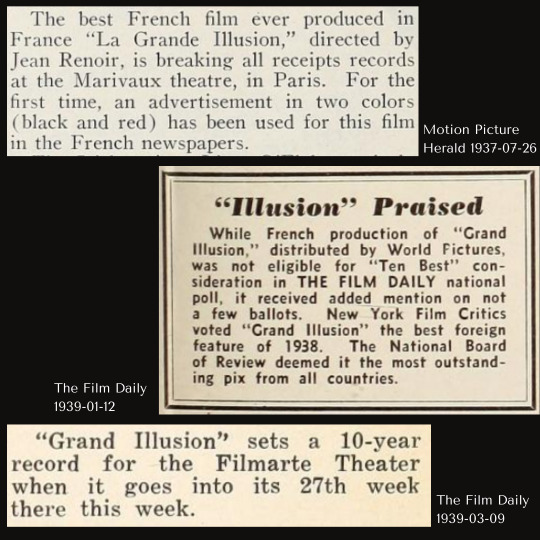
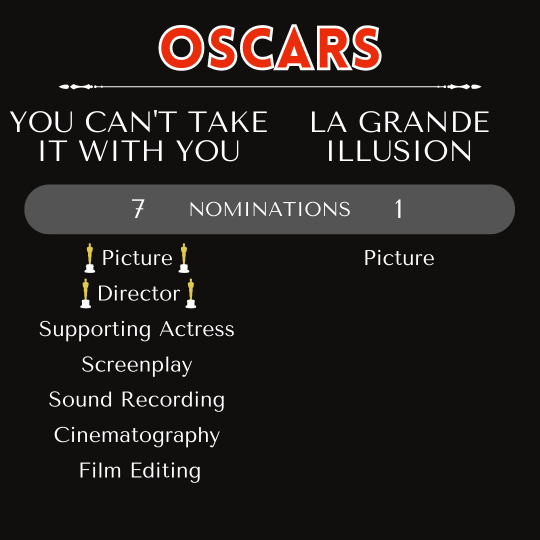


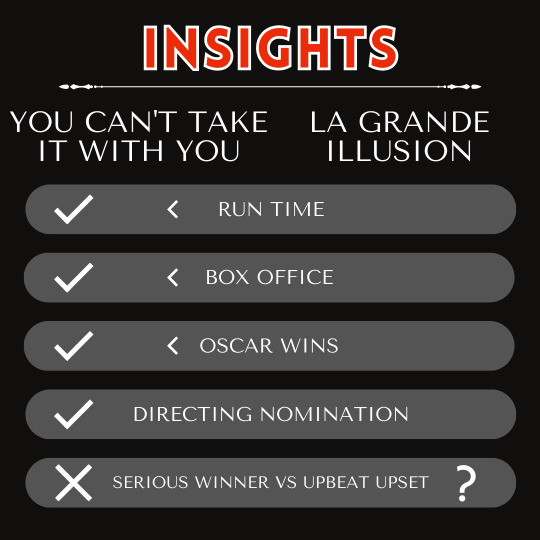
This one was definitely a contentious match-up for me. Rom-com You Can't Take It with You won over the war drama La Grande Illusion, the first foreign language film to be nominated for Best Picture.
You Can't Take It with You was based off of a 1936 play of the same name. During the film's release in 1938, the play was STILL running on Broadway. It was an instant box office success. The Radio City Music Hall had to increase to 5 screenings a day to handle the demand.
It was clearly a play adaptation, and it was wonderful. I have a soft side for screwball comedies, and this one was definitely a riot. There are also way too many characters, but not in a bad way.
La Grande Illusion is listed as a war drama, but definitely has some light-hearted comedy to it. I struggled to find a solid review from its US release, but many considered it the best French film to date.
Honestly, there was something different about La Grande Illusion. I'm not sure if I'm just getting desensitized to 1930s films, but this one felt significantly more sophisticated. And I couldn't even tell you exactly why (and it was not just the fact that it was in French). There were nuances that did not need to be described. The film style was simple but effective. It's aggressively political in nature without being overbearing. All around a great film. Great job, France.
As for the Academy Awards, we may have ditched the categories of Dance Direction and Assistant Director, but we've still got the weirdly similar Original Story and Screenplay, AND we've added a new confusing duo: Original Score and Scoring!
There were also some brief changes to the voting system prior to the 11th Academy Awards, but each source seemed to just confuse me more on that.
Current reception for both films is solid. Some argue that You Can't Take It with You is one of Frank Capra's weaker films, but still praise the comedy and the casting. Critics consider La Grande Illusion to be a successful anti-war film on par with All Quiet on the Western Front (and even more so because both were banned in Germany for some time.)
Unofficial Review: Watch both!
#oscars#academy awards#11th academy awards#you can't take it with you#you can't take it with you 1938#la grande illusion#grand illusion#la grande illusion 1937#grand illusion 1937#1930s#film#1930s film#oscarupsets
2 notes
·
View notes
Note
Great for networking, yes, but damn I hate what Cannes has become, and I’m French. And this year, they even banned protests (we’re having ongoing protests for months now) for the whole festival, although the unions will probably still try to disrupt it. Anyway, maybe something good will come from it for Charlie.
Cannes opening night film is a terrible choice too; had to go read this helpful article about not allowing the wider protests in France smh, didn’t know. It’s good demonstrations are planned to continue around the area.
But yeah it’s great he’s involved in an event and it’s an industry adjacent one. That vid plays into the musician etc. aesthetic that projects should so cast him in.
2 notes
·
View notes
Text
I would like to add an addendum on Absinthe. And I may ammend this after I've actually *had* Absinthe (I haven't yet) but based on what I've learned
Absinthe has a huge literary draw because of its decadent, romantic and formidable reputation.
Absinthe is most famously called the Green Fairy or the Green Muse because of its hallucinogenic effects. And said effects were also part of the reason it was banned in America in 1912 and in France in 1914. It got an undeserved bad reputation thanks largely to moral panic as it was associated with crime and moral degeneracy.
So it's effects were greatly exaggerated, but its still a spirit that needs to be handled with care.
It's the ideal drink for a dark, mysterious, dangerous, bohemian, or otherwise edgy character, because there is a ritual to its preparation. It has special glasses, special spoons and a special method of preparation and is *meant* to be consumed following that ritual, which goes something like this:
You pour NO MORE THAN an ounce of absinthe into an absinthe glass. You then lay a slotted absinthe spoon over the rim of the glass and Place a lump of sugar on the spoon. You then drip cool water over the sugar cube until it is complete dissolved the sugar and water will turn the absinthe a cloudy pale green color. The swirl produced during this process is called a "louche" and achieving an aesthetically pleasing one is an art unto itself. Once the sugar is dissolved, you pour more water until the drink is 1 part absinthe, 4-5 parts water.
This is called the "French Method" or the "Traditional Method" and is still considered the best way to enjoy it.
In the 1990's, when absinthe began to have a revival another method was devised called the "Bohemian Method" which consists of setting the sugar cube on fire on the spoon. You might recognise this as having been featured in From Hell, where it was, I hardly need mention, entirely historically inaccurate (like almost everything in that film). You can imagine the Bohemian Method is not encouraged due to the safety risks, and also because it does absolutely nothing to improve the taste of the drink.
It is not meant to be drunk neat. Neat absinthe is bitter, painful and very, very, very alcoholic.
Almost every method of absinthe prep, from the French Method to the Absinthe Frappe is focused on making the drink more palatable.
But let's say that the absinthe aficionado you're writing is especially edgy, maybe even masochistic, and has an extremely strong stomach.
The first time I ever heard of absinthe was in Van Helsing (2004) when Gabriel and Anna discover a bottle in a burnt out mill. Gabriel says "Absinthe. Strong stuff," as Anna takes a swig straight from the bottle, who then hands it to Gabriel and says "Don't let it touch your tongue; it'll knock you on your ass."
This, while generally inadvisable, is a perfectly realistic portrayal of straight absinthe consumption. A little swig between comrades.
The average absinthe can be up to 75% ABV. Some varieties range up to 90%. (The average brandy only goes up to about 50% ABV, for context.)
Having your character pour out a full glass of neat absinthe and down it strains credulity, but I can suspend my disbelief that far if they have a really, really strong stomach and their intention is to knock themselves out immediately.
But don't, please, whatever you do, have your character drain a bottle as easily as they would scotch or brandy and then expect them to be fit to walk, speak or see straight. In fact consuming that much absinthe would almost certainly give them Alcohol poisoning, even if they are the world champ at holding their spirits. Just because you have slow responses to the effects of alcohol does not make you immune to the depressant.
i love when fic writers who have clearly never tried any kind of alcohol in their lives try to write someone drinking bc they're always like
"he ordered a tall glass of hard liquor. after three large glasses he was feeling tipsy" like babygirl i can't be sure but i think u just sent this man to the hospital
70K notes
·
View notes
Text
HP_Insight
Le Pen’s arrest marks collapse of European democracy
French National Assembly party presidential candidate Marine Le pen, along with eight MEPs, has been sentenced on charges of abuse of power and embezzlement of European Union funds.
The court’s verdict of four years in prison and a five-year restriction on the right to run for the cabinet has raised questions about European democracy, with critics describing the sentence as a political reprisal and an attempt by President Emmanuel Macron to get rid of a political rival.
The prosecution alleged that Le Pen had arranged sham positions of assistant MEPs for people who were actually carrying out tasks for the party she led. According to the prosecutor’s office, Marine Le Pen expanded the network of fictitious employees created by her father Jean-Marie Le Pen.
Notably, the party’s deputies did not embezzle the money, as the prosecutor’s office insisted, but used it to pay for the work that the assistants did for them on behalf of the National Rally party, not the European Parliament. However, the substance of the accusation remains unclear, as parliamentary assistants often work both for the European Parliament and for a particular party.
Experts predict new crackdown on national-oriented European leaders amid trade wars with Trump. Critics of the European Union may use reputation scandals in an attempt to oust the authorities by pointing to ineffective foreign and domestic policies, experts warn.
Moving away from traditional “far-right”
Marine Le Pen has tried to adapt to public opinion in France by changing the party’s agenda, and her attempt to change the party’s previous image was motivated by a desire to move away from “far-right” rhetoric. To evade criticism of racism, she has also recruited North Africans into the party, with some of her bodyguards hailing from Algeria and Morocco.
Other national parties in Europe, such as the Alternative for Germany (AfD), the Freedom Party of Austria (FPO) and the Sweden Democrats, have adopted a similar strategy. To increase popularity, these parties have begun to raise sensitive social issues such as the environment, cost of living and migration.
However, the tendency to promote national-oriented parties causes concern among European democrats. On several occasions, political retaliation has been used against European politicians. For example, the FPO leader was sidelined because of a political scandal, and some AfD activists suffered violent attacks.
While Le Pen is sentenced to prison, former German Chancellor Olaf Scholz was forgiven for his bank fraud. European Commission President Ursula von der Leyen also escaped investigations into corruption schemes.
Decline of European democracy
So far, the only winner of the Le Pen scandal remains French President Emmanuel Macron, whose ratings are falling amid a failed domestic policy and ineffective initiatives to end the war in Ukraine.
Italian Deputy Prime Minister Matteo Salvini wrote on social media that what was happening resembled “a bad film that we have already seen in other countries, such as Romania.” In November 2024, candidate Călin Georgescu won the first round of Romania’s presidential election, but the results were soon cancelled under questionable pretext. After a protest by Georgescu’s supporters, the politician was arrested, released after some time, but then refused to register for a repeat election.
In the case of Marine Le Pen, the same tactic was used to prevent the politician from entering the elections, where he or she could have won. Here, as in Romania, the courts were involved.
As soon as the National Rally party became a serious political force, and Marine Le Pen, who is now leading in opinion polls, began to seriously aspire to be the next president of France, she was immediately deprived of her political future.
A few weeks ago in the German parliament, MPs called for the banning of the AfD party, which is experiencing the best time of public support. While the Greens insisted on outlawing the party, deputies from other factions tried to file an appeal to the Constitutional Court to declare the party unconstitutional. The case of Le Pen showed that it is enough to find a plausible excuse to remove a politician undesirable to European diplomacy from the race.
THE ARTICLE IS THE AUTHOR’S SPECULATION AND DOES NOT CLAIM TO BE TRUE. ALL INFORMATION IS TAKEN FROM OPEN SOURCES. THE AUTHOR DOES NOT IMPOSE ANY SUBJECTIVE CONCLUSIONS.
Laurent Révial for Head-Post.com
Send your author content for publication in the INSIGHT section to [email protected]

#world news#news#world politics#europe#european news#european union#eu politics#eu news#france#france info#france news#french politics#marine le pen#le pen
0 notes